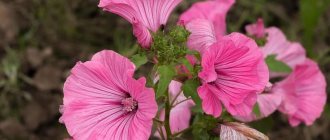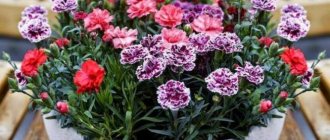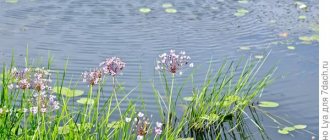Author: Elena N. https://floristics.info/ru/index.php?option=com_contact&view=contact&id=19 Category: Garden plants Published: January 13, 2019Last edits: January 20, 2021
- When to plant
- Growing conditions
- Gigantic
The history of snapdragon, or antirrinum, goes back a long way: its origins are poetically described in ancient Greek myths. The decorative qualities of snapdragon are beyond praise. It is presented in varieties of different heights and all kinds of colors: you can grow antirrinum as a border, as a solo plant, and also in mixed plantings, combining it with other garden crops.
In our article we will tell you about:
- what varieties and varieties of snapdragon are represented in culture;
- how to grow antirrinum in the garden;
- how to care for it;
- how and when to collect snapdragon seeds.
Planting and caring for snapdragons
- Planting: in warm climates, sow seeds in the ground in April or before winter. Seeds are sown for seedlings in mid-March; seedlings are planted in open ground closer to mid-May or early April.
- Flowering: from mid-summer to late autumn.
- Lighting: bright sunlight or partial shade.
- Soil: well-fertilized, breathable, light loamy soil with a pH of 6.0-7.0, cultivated to a depth of 30-40 cm.
- Watering: only in the mornings during dry seasons, plentiful.
- Fertilizing: 2-3 times before flowering with complete mineral fertilizer.
- Reproduction: seeds and cuttings.
- Pests: aphids, root-knot nematodes, spider mites, cutworms, thrips, slugs.
- Diseases: late blight, fusarium, verticillium, blackleg, septoria, sclerotinia and downy mildew.
Read more about growing snapdragons below.
Snapdragon flowers or antirrhinum, are a genus of herbaceous plants of the Plantain family, covering about 50 species of perennials, including climbing ones, common in the warm zones of the Earth, but mostly in North America. The Russians call this plant “dogs,” the British call it “snapdragon” (biting dragon), the French call it “wolf’s mouth,” and the Ukrainians call it “mouth.” From the Greek, the name “antirrinum” is translated as “nose-like”, “nose-like”.
An ancient Greek myth tells about the first labor of Hercules, when he defeated the Nemean lion, famous for its ferocity and invulnerability. The goddess Flora presented Hercules with a beautiful flower she created in honor of his victory, which she called “snapdragon.” Since then, it has become a tradition in Greece to give snapdragons to heroes. The snapdragon flower has been in culture for about five hundred years, and breeding work was started by German scientists in the 19th century, and today about 1000 varieties of snapdragon are grown in the gardens of the planet, and the most interesting thing is that the basis for this variety of forms and hybrids was a single species – Antirrhinum majus.
- Four prerequisites for petunia to grow lush and beautiful
Lampion F1
Ampelous annual hybrid. Forms a lush hanging “beard” 50-70 cm long and up to 1 m wide. One of the “basic” ampelous antirrhinums.
The plant prefers sunny places, is cold-resistant, ideal for container growing. Requires fertilizing.
Flowering is abundant and long lasting from June to September.
The flowers are medium sized but numerous and come in a variety of colors (from white and yellow to pink and maroon). The aroma is moderate and pleasant. Not for cutting.
Botanical description
The snapdragon plant is a subshrub or herbaceous plant with straight, branched green, finely grooved stems from 15 cm to one meter in height, forming pyramidal bushes. The upper leaves of the snapdragon are alternate, the lower ones are opposite, their shape is elongated oval or lanceolate, the color is from light green to dark green with red veins.
How to sow calendula and how to care for it
The flowers are fragrant, rather large, irregular, two-lipped, depending on the variety, simple or double, collected in spike-shaped inflorescences, and are colored white, yellow, pink, soft fawn, all shades of red, but there are also two-color and even three-color varieties. The fruit is a two-locular multi-seeded capsule, with 5,000 to 8,000 seeds in one gram. Flowering of snapdragon usually begins in June and ends with frost.
Most often, the perennial snapdragon in nature is grown in gardening as an annual plant, but with good care and favorable conditions, the cold-resistant snapdragon can successfully overwinter in the garden and bloom more beautifully the next year. In garden design, antirrhinum is grown as a border plant, although snapdragons look great both in a flowerbed and planted in groups against a green lawn. Snapdragons are often used to decorate balconies and terraces.
Of particular interest to gardeners today are ampelous forms of snapdragons, which can be grown in hanging structures to decorate terraces and galleries.
In the photo: Snapdragon flowering in the garden
Diseases and pests
The beautiful snapdragon plant, if not properly cared for, is susceptible to the following diseases:
- Rust. Depressed light spots will be visible on top, and yellow spots below, which will then darken and acquire a reddish tint. Airborne. The flower withers and dies.
- Downy mildew. You can observe the appearance of whitish areas on the upper part of the leaves, and on the lower part - a white or brown layer. For prevention, dense plantings and high humidity in greenhouses should not be allowed. Treat with copper preparations; before using them, remove all affected leaves.
- Powdery mildew. Characteristic is the formation of a white coating on all parts of the plant. It is better to select varieties that are resistant to this disease.
- Brown rot. The foliage brightens, then turns yellow and falls off. When the root is removed, it is clear that it has become rotten and soft. Develops with frequent watering or in soil with low acidity.
- Brown rot. The color of the stem changes at the base. Seedlings and still immature plants are susceptible. When planting, seedlings should not be planted deep.
Insects, butterflies that lay eggs, and other pests may attack.
Affected plants are promptly removed, and their growing area is treated with special solutions.
Growing snapdragons from seeds
Sowing seedlings
Snapdragon reproduces by generative and vegetative methods. Snapdragon seeds retain the ability to germinate for several years. If you live in a warm climate, you can grow snapdragons from seeds, sowing them directly into the ground, and they will sprout in two and a half to three weeks, without any problems surviving even a slight cold snap at night, which is common in spring, but in areas where it is warm occurs gradually, it is better to use the seedling method of growing snapdragons. How to grow snapdragons from seeds using seedlings? This process is neither complicated nor labor-intensive.
So, we sow snapdragons: at the beginning of March, pour coarse sand into bowls with a diameter of at least 10 cm with drainage holes, and on top of the sand - compost soil mixed with sand, compact it, level it, sprinkle it with water from a sprayer and distribute it over its surface in the same way seeds mixed with sand, which we then cover on top with a thin layer of the same substrate, moisten it with a fine spray bottle and cover the sowing bowl with glass.
Conditions for growing healthy asters
Every day we remove condensation from the glass, let the crops breathe and, if necessary, moisten the soil with a sprayer. At a temperature of 23 ºC and moderate substrate humidity, sprouts will appear in a couple of weeks. As soon as this happens, move the bowl to a bright, non-sunny place so that they do not stretch out, and as soon as the emergence of seedlings becomes widespread (in 3-4 days), remove the glass.
In the photo: Growing snapdragon from seeds
Seedling care
The seedlings will grow slowly at first, and your task during this period is to ensure proper soil moisture, watering the soil in the morning so that there is enough moisture, but not in excess, as this can lead to seedlings becoming infected with blackleg. “Fallen” sprouts should be removed with tweezers, and the place where they grew should be powdered with crushed coal or sprinkled with a small amount of calcined and cooled river sand. After a pair of true - not cotyledon - leaves appear, the seedlings dive into a container or box, placing them so that they grow freely.
You can plant seedlings in individual pots or, for example, plant three sprouts in larger pots.
Place the picked seedlings in a bright place, protecting them from direct sunlight, and begin to gradually accustom them to the environment and temperature in which they will find themselves after transplanting into open ground: open the window slightly during the day for a while, but make sure that the seedlings do not found herself in a draft. The central shoot of each seedling after the development of 4-5 leaves must be pinched to enhance tillering, but if the side shoots are also growing too actively, pinch them too.
Pictured: Red snapdragon
Preparing seeds for seedlings
Antirrinum seeds are very small - 1 g contains about 7000 pieces. It is quite difficult to work with such seeds, but they still must undergo minimal pre-sowing treatment.
How to do this correctly?
- Prepare a low plastic container, cotton pads, pieces of cotton fabric, growth stimulator Epin and, in fact, the seeds themselves.
- Place half of the cotton pads in a container and place pieces of fabric on top. This is done so that small seeds do not become entangled in the cotton fibers and can be easily removed for further work.
- Place the seeds on a cloth and cover with another similar piece of cloth, and on top with the other half of the disk. If several varieties are sown, the discs can be labeled.
- Prepare a solution of Epin - add 2 drops of the drug to 100 ml of water, mix well and pour cotton pads so that they are only well saturated with the solution, but do not float in it.
- Leave the seeds in this state for 2-3 hours, no more, this is important, epin can have a negative effect on the seed shell if it is exposed to it for a long time.
- Now you need to remove the discs from the container and lightly, very carefully, squeeze out excess liquid.
- The seeds are ready to be planted in the ground. Pre-sowing treatment with epin will allow for more vigorous seedlings, enhancing seed activity and plant immunity.
Planting snapdragons
When to plant
At the end of May - beginning of June, grown, strengthened and hardened seedlings are planted in open ground. And don’t be afraid of the last night’s cold snaps: your young “lion cubs” will survive them calmly. The site for growing snapdragons can be either sunny or slightly shaded, but must be well drained and protected from strong winds. The soil needs to be light and nutritious. The best soil for snapdragons is a mixture of sand, compost and peat in approximately equal proportions. The optimal soil pH for snapdragon is pH 6-8.
- Aubrieta: growing from seeds, types and varieties
In the photo: Snapdragon in a flowerbed
How to plant
Planting snapdragon flowers is carried out according to the following scheme: tall varieties are planted at a distance of 40-50 cm from each other, medium-sized varieties - at a distance of 30 cm, low-growing varieties - after 20 cm, dwarf varieties - after 15 cm. As soon as the snapdragon takes root, it begins to grow very grow quickly and turn into a lush flowering bush. You should know that snapdragons are planted in well-moistened soil.
Requirements for soil and planting site
Planting and care after planting require compliance with certain rules.
Soil: grows well in any variety, but fertile, humus, constantly moist, but not waterlogged soils are preferred. Well-drained sandy loam soil, preferably calcareous or with a neutral reaction, is better suited.
This plant requires rather a mineral substrate (excess peat should be avoided) and is sensitive to salinity. Moderate soil moisture should also be maintained.
Position: The position should be sunny or partially shaded.
Snapdragon Care
Growing conditions
This plant is unpretentious and needs only what any garden flower needs: watering, loosening the soil, removing weeds and fertilizing. You will only have to water the plants in dry times when there is no rain, but not at night. The next day after watering or the same day in the evening, it is advisable to loosen the soil and weed out the weeds. It is advisable to tie tall varieties of snapdragon to a support. It is better to pick off wilted flowers so that the plant does not waste energy on them.
If you want to get snapdragon to bloom for a long time, do not let it set seeds, remove the flower shoot as soon as the last flowers have withered. You need to cut off the peduncle under the lowest flower, then new arrows and new flowers will appear.
As soon as the plant takes root in the ground after planting, it needs to be fed with nitrophoska and organic matter, the second feeding is carried out when the snapdragon begins to form buds, and in this case, a urea solution, potassium sulfate and superphosphate are used at the rate of one tablespoon of each ingredient per 10 liters water.
In the photo: Pink flowers of antirrinum
Pests and diseases
Sometimes red rust spots appear on the plant; septoria, black leg, gray or root rot can affect the snapdragon. Diseased specimens should be immediately removed and burned, and the soil in the place where they grew should be treated with an antifungal drug (fungicide).
How to grow sweet peas from seeds - a proven method
Dangerous insect pests include scale insects, fly larvae, caterpillars and butterflies that lay eggs. It is always easier to take preventive measures than to treat an already existing disease or expel insects that have settled in flowers, so follow the recommendations for caring for the plant, promptly remove diseased or pest-affected specimens, do not allow plants to grow too close to each other, maintain moderation in moistening the area, by watering flowers at the root, and not at the leaves, and the snapdragon will not be afraid of either diseases or insects.
In the photo: Growing snapdragons
Care after flowering
Snapdragons can bloom until autumn frosts, but when autumn sets in, cut the snapdragons, if you grow them as a perennial plant, so short that the rest of the stem rises above the ground 5-8 cm high, and cover the area with peat with sawdust or dry foliage - mulch will help plants survive the winter. If you are growing an annual snapdragon, then to avoid self-seeding during the entire flowering period, pick off the wilted flowers in a timely manner, and when all the flowers on the arrow have faded, cut the peduncle as low as possible. This must be done in order to prevent the seeds from ripening and falling on the ground. When deep autumn arrives, dig up the area and burn the remains of the plants to destroy the pests that have settled in them.
In the photo: Snapdragon flower
Soil preparation and disinfection
For small seeds, the soil should be free of large particles. Therefore, it must be sifted through a large sieve or plastic box.
You can buy ready-made primer in the store - the usual universal one for flowers, or you can prepare it yourself. Soil composition – peat, turf soil, vermiculite, sand in a ratio of 1:1:0.5:0.5. If you don't have vermiculite, you can do without it.
Now the soil needs to be disinfected. This can be done in two ways: by heating in the oven or by pouring a solution of potassium permanganate. The second method, of course, is easier, but it does not provide 100% protection against dangerous microorganisms and fungi that cause seedling diseases.
In order to prepare the soil using the first method, you need to place it on a baking sheet, lightly sprinkle with water and place in an oven heated to 100°C for 2 hours. After cooling, spread the soil into containers where the seedlings will be grown.
It is very good if the soil, after disinfection and cooling, undergoes additional treatment with the biological product phytosporin, which will provide it with beneficial microflora. To prepare a solution, add 50 mm of phytosporin in liquid form to 1 liter of warm water.
You need to sprinkle the soil with a solution of this drug on top, cover the top with cling film and leave in a warm place for a day, or less - there will be no harm from phytosporin.
How and when to collect seeds
The seeds of most garden plants are collected when they are fully ripe. But snapdragon seeds need to be harvested in the incomplete ripeness phase, so that they can then be ripened in a dry room with good ventilation. Collection is carried out in a long paper bag, as for a baguette. They start collecting seeds when the fruits on the lower part of the peduncle ripen: the upper part of the peduncle, on which the fruits are still green, is cut off and thrown away, and a paper bag is put on the remaining part of the flower shoot, tied with a thread below the fruits and the shoot below the bandage is cut off. The inverted bag is hung in a warm, dry room and waiting for the ripened seeds to pour out of the boxes into the bag. Then they are placed in cardboard boxes and stored at a temperature of +3-5 ºC, protected from possible moisture.
In the photo: Antirrhinum flower
Greenhouse care
The plants in the greenhouse need to be provided with the maximum amount of light, only the seedlings should be shaded. The air temperature should not exceed 15 °C; Frequent ventilation is also necessary.
In heated plastic tunnels, this plant can be grown as in a greenhouse, while in unheated rooms it is recommended to grow it mainly for collecting flowers in late spring (May-June) and early autumn (September-October). Summer is less favorable for growing this plant in a plastic tunnel due to the persistence of too high temperatures and high humidity. Spring cultivation under film can be a good precursor to autumn cultivation of chrysanthemums.
Temperature:
- At night, the plant should be kept at a temperature between 8-10 ° C;
- during the day – from 1 to 15 °C.
It is necessary to frequently ventilate the greenhouse and provide the plants with the maximum amount of light.
The plant responds favorably to long days, which accelerates the swelling of flower buds. Tall varieties require support to ensure growth.
Types and varieties of snapdragon
Today in professional floriculture there are several classifications of snapdragons, and the most common of them is based on plant height. According to this criterion, varieties are divided into five groups:
Gigantic
The height is from 90 to 130 cm. The central shoot of plants of this group is much higher than the second-order shoots; there are no third-order shoots. Varieties: Arthur - cherry color, 90-95 cm high, F1 red XL and F1 pink XL, 110 cm high, respectively red and pink.
High
From 60 to 90 cm, grown for cutting or as a vertical accent in mixborders or groups. The side shoots are much lower than the central one. When cut, tall snapdragon lasts up to a week or longer; the most fragrant varieties are those with yellow shades. Popular varieties: Anna German - soft pink snapdragon, Canary - a bright yellow variety, a mixture of varieties Madame Butterfly - double snapdragon of different shades and others.
Pictured: Yellow snapdragon
Tall or medium tall
Representatives of the variety reach 40-60 cm in height; they are universal varieties, grown both as flowerbed decorations and for cutting. They are distinguished by strong branching. A characteristic feature of the varieties of this group is also that the central shoot is slightly higher than the side shoots. Varieties: Golden Monarch - yellow, Ruby - bright pink, Lipstick Silver - pinkish-white.
Low
From 25 to 40 cm in height, grown as flowerbed or border flowers. These varieties have many flowering shoots of the second and third order, but the main shoot is at the same level or slightly lower than the shoots of the first order. Varieties: Hobbit, Tip-top, hanging hybrid Lampion.
- How to feed roses in the fall to prevent them from freezing in winter?
In the photo: White snapdragon
Dwarf
15-20 cm in height, flowers for borders, carpet flower beds, rock gardens and ridges. They are also grown as potted plants. These varieties are distinguished by strong branching up to shoots of the third and fourth order, the main shoot is usually lower or at the level of shoots of the second order. Varieties: Sakura Color - a pinkish-white variety with a spot, Candy Showers - an ampelous snapdragon.
In addition to this classification, there is an equally popular classification by Sanderson and Martin for year-round cut varieties, but it is of interest only to those for whom growing snapdragons is not a pleasure or an aesthetic need, but a means of enrichment.
Application
The flower has found wide application not only in the garden, but also in the medicine cabinet and in the kitchen.
In landscape design
These flowers were sown in the flowerbeds of our grandmothers; they became a symbol of gardens in a naturalistic style. Due to its decorative value, the plant can be grown in the garden and on the balcony or terrace.
In landscape design, different varieties are used as follows:
- dwarf varieties are suitable for flowering carpets, borders, balcony boxes, terrace containers;
- large antirrinum is used for planting in rural gardens, as well as for designing summer seasonal gardens and flower beds;
- medium-sized varieties are used for flower beds and flowerbeds of the same type - they create spectacular, multi-colored spots;
- high varieties are suitable for cut flowers, they remain fresh for a long time - up to 8 days.
The ampelous snapdragon looks beautiful in pots on the terrace or balcony.
The plant is suitable for creating colorful carpets. Can be combined with other colors of a similar look. Because its flowers do not fade, gap-filling plants can be paler in color, providing an interesting contrast.
Combination with other plants:
- white and yellow varieties look good with gaillardia;
- A simple and elegant composition can be created by combining antirrhinum with marigold (calendula).
In folk medicine
- In Mediterranean countries, antirrinum is considered a medicinal plant and is used to treat ulcers, heartburn, and hemorrhoids.
- It was previously used to treat scurvy.
- A tea is made from it and is used to relieve bloating.
- An infusion of flowers is used for headaches.
According to scientific research, Antirrhinum seeds have a high fat content (12.3%). They are a source of essential fatty acids, neutral lipids, glycolipids and phospholipids. The high content of linoleic and oleic acids (88% of all fatty acids) makes them very nutritious.
Seed oil is characterized by a relatively high content of phytosterols. All tocopherol isomers are present in the flowers of this species, of which α-tocopherol constitutes 81% of their total content. Antirrhinum seed oil has also been shown to have higher free radical scavenging activity than olive oil. These properties are important in the pharmaceutical and food industries.
The flowers of the plant are rich in natural dyes from the group of polyphenols and L-ascorbic acid. They are characterized by a high content of mineral compounds - phosphorus, potassium, calcium, magnesium, sodium. Flowers contain iron, manganese, copper, zinc, molybdenum.
Flowers have anti-inflammatory, diuretic, antispasmodic properties, and soothe a runny nose. In natural medicine they are used as compresses for swelling.
Beneficial features
Previously (mainly in the East), a decoction of snapdragons was used as an antidote. The mixture with lily oil was supposed, according to people, to keep facial skin in good condition.
Nowadays, traditional medicine suggests using the plant to treat eye diseases, diseases of the gastrointestinal tract, liver, genitourinary system, and even common colds.
At the moment of flowering of the antirrinum, the racemose inflorescences and upper leaves are collected. The workpieces are dried in a well-ventilated area, in the shade. Subsequently, the raw materials are used to make ointments, decoctions and tinctures.
Wintering the plant
Despite the fact that snapdragon is characterized as a perennial plant, cultivated varieties do not always tolerate frost well. If the winter is windy, little snow and very cold, then some species freeze out.
To save plants for next year you will have to work hard:
- at the end of autumn, while there is no frost, carefully trim the bush so that a stem no more than 10 cm long peeks out of the ground;
- It is important to build a good shelter: first, they hill up the antirrhinum, then put spruce branches, a layer of fallen leaves, humus or peat on the mound of earth (the thickness of the cover is up to 10 cm);
- With a careful approach and proper arrangement of the protective layer, the soil does not freeze, and young antirrhinums appear in the spring. You can leave the overwintered bushes in the same place or plant the decorative species in other areas.
Cold resistance
Snapdragon compares favorably with many flowering plants in its ability to withstand frosts down to -4 degrees, therefore, you can see its luxurious flowering until the frosts. But we should not forget that frozen shoots practically do not develop fully and remain low and puny.
At the same time, the seeds ripen. They can also be collected to grow a luxurious plant in any conditions convenient for you next year.
Important:
The only thing that snapdragons cannot tolerate, and this is something all gardeners must keep in mind, is drought. Moreover, drought is undesirable for him both in the ground and in the air. Therefore, antirrinum requires not only watering, but also spraying.
How to care after flowering
Advice! The varieties you like can be transplanted into a pot and kept at a temperature no higher than 15˚. They will bloom all winter.
When growing perennial snapdragons, the bushes are cut off, leaving a 5-8 cm stump, which is covered with mulch, insulated and left to overwinter.
When growing annual antirrinum, faded shoots must be cut off to avoid self-seeding. They are burned to destroy pathogens and pests, and the area is dug up. For propagation by self-sowing, several flower stalks are left on which the seeds will ripen and fall into the ground. They will sprout in the spring.
Planting seeds in open ground
The method is less popular than growing beautifully flowering snapdragon seedlings. Seeds are sown directly on a lawn or flowerbed if warm weather sets in in the region already in May, frosts are rare, spring is early, and the soil warms up quickly.
Suitable timing
The right time is early May. It is important that there are no night frosts. It is important to select high-quality, large seeds. Some gardeners advise keeping the planting material in a solution of potassium permanganate for disinfection (30 minutes) and then placing the seeds in a growth stimulator for 3 hours.
Choice of location and lighting
Snapdragon grows well in open areas, light shade is acceptable. When planting antirrinum under trees, in shaded areas, the flowers are small, the bushes do not stretch out as expected for a certain variety, and the decorative effect is reduced.
Optimal options: flat terrain, not in a lowland, not in a swampy area, away from trees with a dense crown. In the complete absence of shade, the plants bloom well; it is only important to ensure timely soil moisture. You must follow the landing rules.











